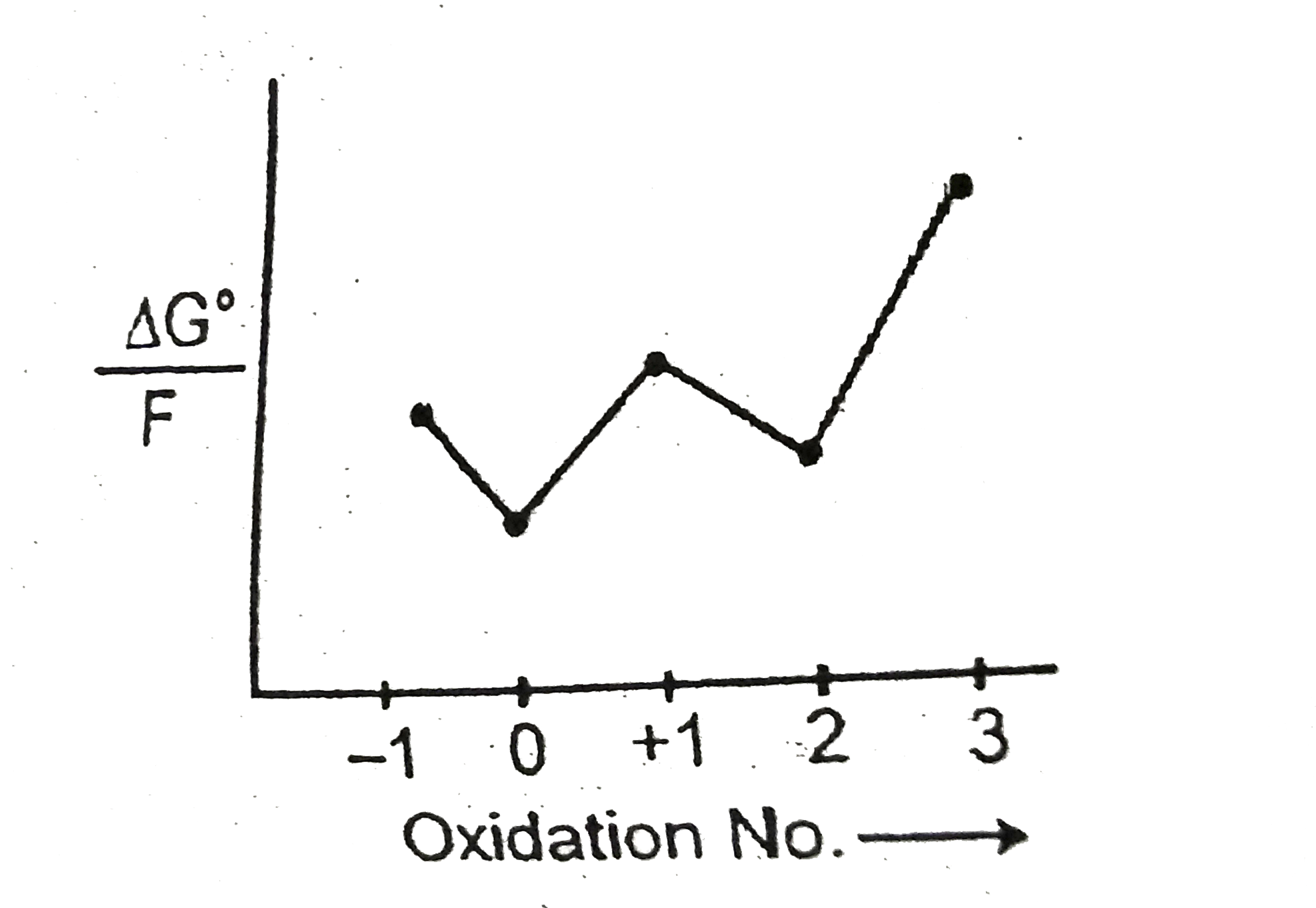If an element can exist in several oxidation states, it is convernient to display the reduction potentials correspondingg to the various half reactions in diagrammatic form, know as latimer diagram the latimer diagram for chlorine in acid solutio is
CIO−4+1.20V−−−−→CiO−3+1.18V−−−−→HClO2+1.60V−−−−→HClO1.67V−−→Cl21.36V−−→Cl− in basic solution.
ClO−40.37V−−→ClO−30.30V−−→ClO−20.68V−−→ClO−0.42V−−→Cl21.36V−−→Cl− The standard potentials for two nonadjacent species can also be calculateed by using the concept that △G∘ as an additive property but potential is not an additive property and △G∘=−nFx0. if a given oxidation stateis a stronger oxidising agent than the next higher oxidation state, disproportionation can occur. The reverse of disproportionation is called comproportionation. The relative stabilities of the oxidation state can also be understood by drawing a graph of △G∘/F against oxidation state, known as frost diagram, choosing the stability of zero oxidation state arbitrarily as zero. The most stable oxidation state of a species lies lowest in the diagram, disproportionation is spontaneous if the species lies above a straight line joining its two product species.
Q. Which of the following statement is correct?
A+1 undergoes disproportionation into A and A2+
A2+ undergoes disproportionation in A and A3+
A undergoes comporportionation in A+1 and A−1
All of the above.
The correct Answer is:A
Step by step video & image solution for If an element can exist in several oxidation states, it is convernient to display the reduction potentials correspondingg to the various half reactions in diagrammatic form, know as latimer diagram the latimer diagram for chlorine in acid solutio is CIO_(4)^(-)overset(+1.20V)toCiO_(3)^(-)overset(+1.18V)toHClO_(2)overset(+1.60V)toHClOoverset(1.67V)toCl_(2)overset(1.36V)toCl^(-) in basic solution. ClO_(4)^(-)overset(0.37V)toClO_(3)^(-)overset(0.30V)toClO_(2)^(-)overset(0.68V)toClO^(-)overset(0.42V)toCl_(2)overset(1.36V)toCl^(-) The standard potentials for two nonadjacent species can also be calculateed by using the concept that triangleG^(@) as an additive property but potential is not an additive property and triangleG^(@)=-nFx^(0). if a given oxidation stateis a stronger oxidising agent than the next higher oxidation state, disproportionation can occur. The reverse of disproportionation is called comproportionation. The relative stabilities of the oxidation state can also be understood by drawing a graph of triangleG^(@)//F against oxidation state, known as frost diagram, choosing the stability of zero oxidation state arbitrarily as zero. The most stable oxidation state of a species lies lowest in the diagram, disproportionation is spontaneous if the species lies above a straight line joining its two product species. Q. Which of the following statement is correct? by Chemistry experts to help you in doubts & scoring excellent marks in Class 12 exams.
Updated on:21/07/2023Topper's Solved these Questions
- ELECTROCHEMISRYBOOK - RESONANCE ENGLISHCHAPTER - ELECTROCHEMISRYEXERCISE - Exercise 3
7 Videos
- ELECTROCHEMISRYBOOK - RESONANCE ENGLISHCHAPTER - ELECTROCHEMISRYEXERCISE - Part 2
23 Videos
- ELECTROCHEMISRYBOOK - RESONANCE ENGLISHCHAPTER - ELECTROCHEMISRYEXERCISE - Objective Questions
41 Videos
- ELECTRO CHEMISTRYBOOK - RESONANCE ENGLISHCHAPTER - ELECTRO CHEMISTRYEXERCISE - PHYSICAL CHEMITRY (ELECTROCHEMISTRY)
53 Videos
- EQUIVALENT CONCEPT & TITRATIONSBOOK - RESONANCE ENGLISHCHAPTER - EQUIVALENT CONCEPT & TITRATIONSEXERCISE - Part -IV
22 Videos
Similar Questions
If an element can exist in several oxidation states, it is convernient to display the reduction potentials correspondingg to the various half reactions in diagrammatic form, know as latimer diagram the latimer diagram for chlorine in acid solutio is
CIO−4+1.20V−−−−→CiO−3+1.18V−−−−→HClO2+1.60V−−−−→HClO1.67V−−→Cl21.36V−−→Cl− in basic solution.
ClO−40.37V−−→ClO−30.30V−−→ClO−20.68V−−→ClO−0.42V−−→Cl21.36V−−→Cl− The standard potentials for two nonadjacent species can also be calculateed by using the concept that △G∘ as an additive property but potential is not an additive property and △G∘=−nFx0. if a given oxidation stateis a stronger oxidising agent than the next higher oxidation state, disproportionation can occur. The reverse of disproportionation is called comproportionation. The relative stabilities of the oxidation state can also be understood by drawing a graph of △G∘/F against oxidation state, known as frost diagram, choosing the stability of zero oxidation state arbitrarily as zero. The most stable oxidation state of a species lies lowest in the diagram, disproportionation is spontaneous if the species lies above a straight line joining its two product species.
Q.
For a hypothetical element, the frost diagram is shown in figure.? which of the following oxidation state is least stable?
View SolutionIf an element can exist in several oxidation states, it is convernient to display the reduction potentials correspondingg to the various half reactions in diagrammatic form, know as latimer diagram the latimer diagram for chlorine in acid solutio is
CIO−4+1.20V−−−−→CiO−3+1.18V−−−−→HClO2+1.60V−−−−→HClO1.67V−−→Cl21.36V−−→Cl− in basic solution.
ClO−40.37V−−→ClO−30.30V−−→ClO−20.68V−−→ClO−0.42V−−→Cl21.36V−−→Cl− The standard potentials for two nonadjacent species can also be calculateed by using the concept that △G∘ as an additive property but potential is not an additive property and △G∘=−nFx0. if a given oxidation stateis a stronger oxidising agent than the next higher oxidation state, disproportionation can occur. The reverse of disproportionation is called comproportionation. The relative stabilities of the oxidation state can also be understood by drawing a graph of △G∘/F against oxidation state, known as frost diagram, choosing the stability of zero oxidation state arbitrarily as zero. The most stable oxidation state of a species lies lowest in the diagram, disproportionation is spontaneous if the species lies above a straight line joining its two product species.
Q. What is the potential couple ClO−Cl− at pH=14?
View Solution
Knowledge Check
Using the following Latimer diagram for bromine,
pH=0,BrO−41.82V−−→BrO−31.50V−−→HBrO1.595V−−−→Br21.06552V−−−−→Br−
the species undergoing disproportionation isABrO−4BBrO−3CHBrODBr2
Find out the compounds that will disproportionate in their aqueous solution.
(I)ClO−4overst(+0.36V)→ClO−3+0.33V−−−−→ClO2+0.66V−−−−→OCl−+0.40V−−−−→12Cl2+1.36−−−→Cl−
(II)MnO−4+0.56−−−→MnO2−4+2.22V−−−−→MnO2+0.95V−−−−→Mn3++1.55−−−→Mn2+(−0.19)V−−−−−−→Mn
View SolutionCH3−CH3∣CH−NO2NaNO2+H2SO4−−−−−−−−−−−−→at0∘C(A). (A) is:
View SolutionWhich H atom in the following ester is most acidic ?
1CH3−2CH2−O∣∣C−3CH2−O∣∣C−O−4CH25CH3
View SolutionIn 1CH2=2CH−3CH2−4C≡5CH, the C2−C3 bond involves the hybridization of the type :
View SolutionGive IUPAC name for each of the following
H34C−O∣∣3C−2CH2−O∣∣1C−OH
View SolutionArrange nucleophilicity of given species in decreasing order:
(1) CH3−өCH2
(2) CH3−өO
(3) өNH2
(4) өF
View SolutionName the type of reactions for the following chemical equations.
2SO2+O2V2O5⇐⇒2SO3
View Solution
